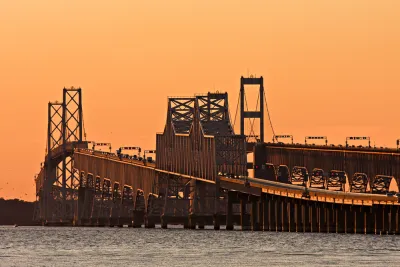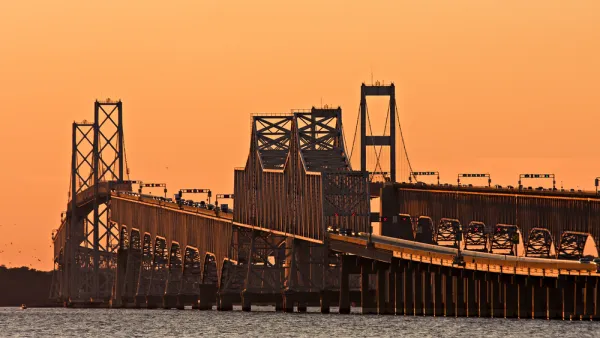Maryland Governor Larry Hogan has thrown support behind a study to add a third span to the Bay Bridge that spans the Chesapeake Bay.

"Gov. Larry Hogan said Tuesday that the state will spend $5 million and up to four years studying where to put — and how to pay for — a possible third span across the Chesapeake Bay," reports Erin Cox. The bridge could potentially cost $6.85 billion.
"The congested and aging Bay Bridge has vexed transportation planners for decades," according to Cox. Apparently the construction of the bridge is still sturdy, and will remain so until 2065. "But increased traffic is projected to cause daily 13-mile backups by 2040 unless a new span is built." The bridge currently carries about 70,000 vehicles a day. That total is expected to grow to 92,000 by 2040. The Bay Bridge "carries U.S. 50 and 301 from Anne Arundel County on the Western Shore across the Chesapeake to Queen Anne's County on the Eastern Shore," according to Cox.
The Hogan Administration has taken congestion relief considerations further than previous politicians by commissioning this study, and Governor Hogan has shown support for highway projects in the past, while also refusing to fund the now defunct $2.9 billion Baltimore Red Line light rail project.
FULL STORY: Hogan announces plan to study building third Bay Bridge span

National Parks Layoffs Will Cause Communities to Lose Billions
Thousands of essential park workers were laid off this week, just before the busy spring break season.

Retro-silient?: America’s First “Eco-burb,” The Woodlands Turns 50
A master-planned community north of Houston offers lessons on green infrastructure and resilient design, but falls short of its founder’s lofty affordability and walkability goals.

Delivering for America Plan Will Downgrade Mail Service in at Least 49.5 Percent of Zip Codes
Republican and Democrat lawmakers criticize the plan for its disproportionate negative impact on rural communities.

Test News Post 1
This is a summary

Test News Headline 46
Test for the image on the front page.

Balancing Bombs and Butterflies: How the National Guard Protects a Rare Species
The National Guard at Fort Indiantown Gap uses GIS technology and land management strategies to balance military training with conservation efforts, ensuring the survival of the rare eastern regal fritillary butterfly.
Urban Design for Planners 1: Software Tools
This six-course series explores essential urban design concepts using open source software and equips planners with the tools they need to participate fully in the urban design process.
Planning for Universal Design
Learn the tools for implementing Universal Design in planning regulations.
EMC Planning Group, Inc.
Planetizen
Planetizen
Mpact (formerly Rail~Volution)
Great Falls Development Authority, Inc.
HUDs Office of Policy Development and Research
NYU Wagner Graduate School of Public Service




























